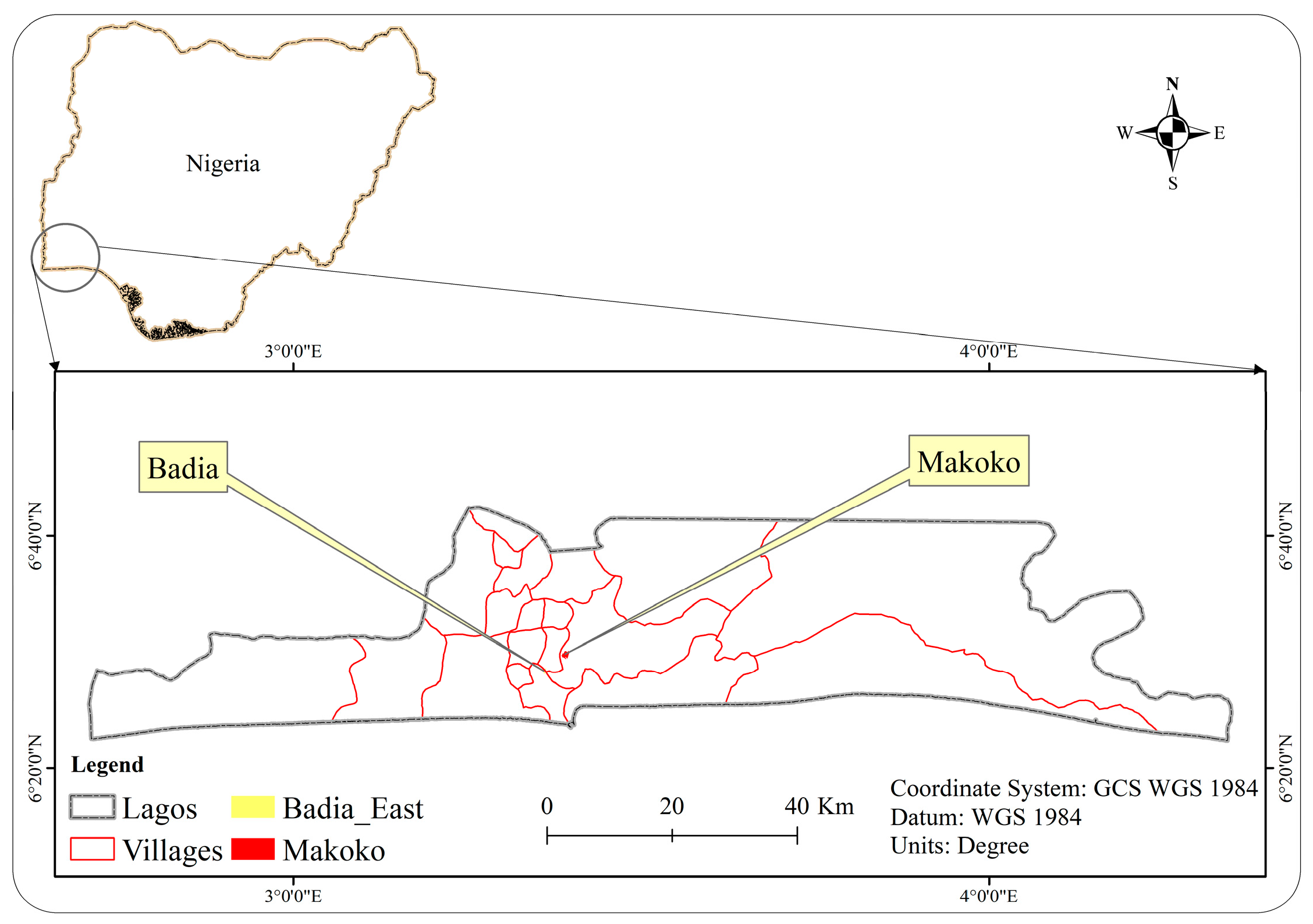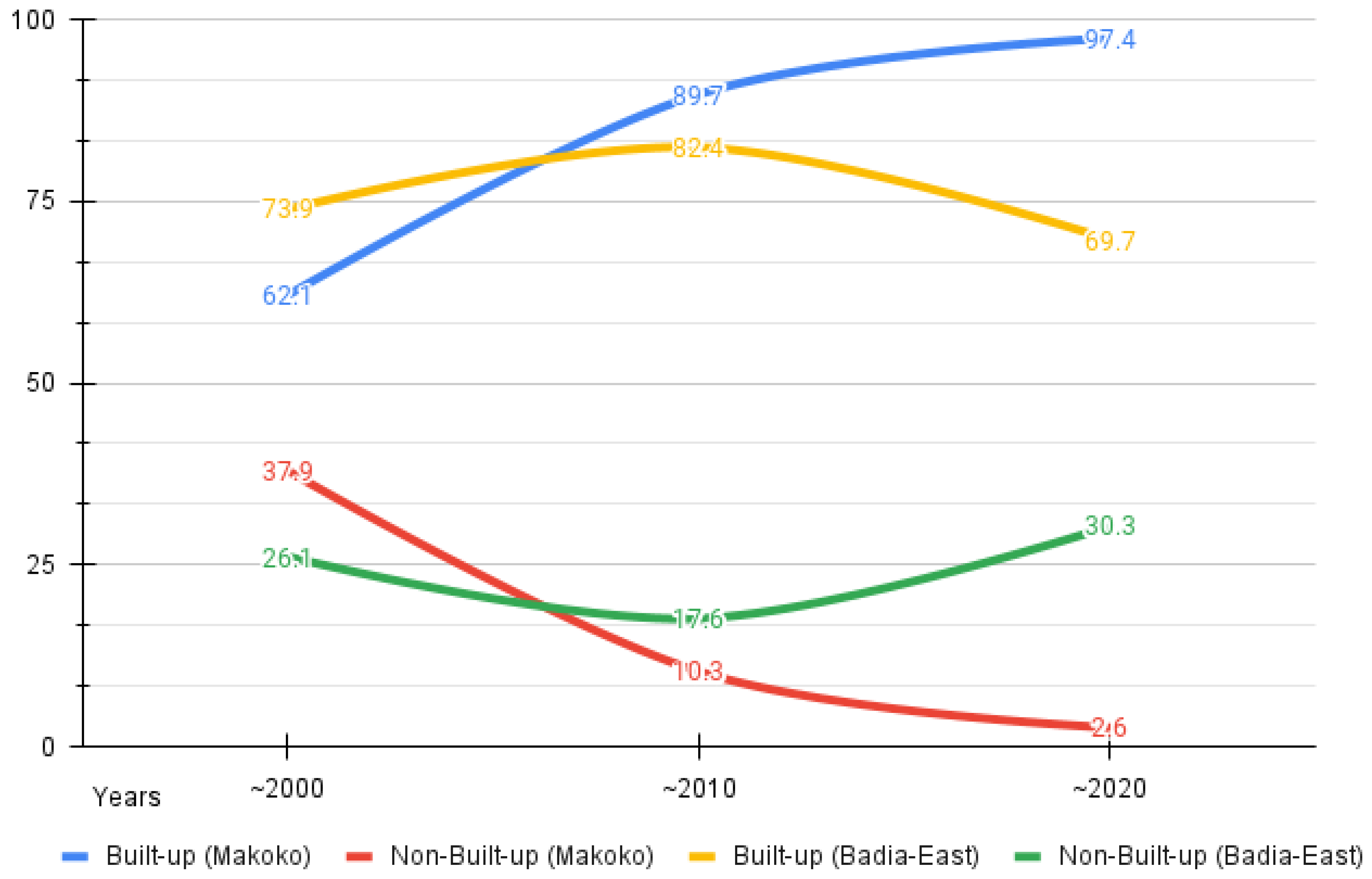1. Introduction
The rapid urbanization witnessed in various regions of the Global South has resulted in a significant and widespread outcome: The proliferation of slums [
1,
2]. More than 1 billion people live in informal settlements globally, mainly in the Global South. Projections suggest that by 2030, this number will reach 2 billion; by 2050, it will reach 3 billion if current trends continue. The growth of informal settlements in the Global South is due to the inability to meet the needs of this growing population [
3]. Inadequate infrastructure and essential services make urbanization a challenge for these countries. A slum, as defined, is a residential area formed by residents without government oversight. These areas are commonly characterized by substandard housing, a lack of essential services, and frequent overcrowding [
4,
5]. According to UN-Habitat’s definition, a slum is an urban residential area with a dense population marked by deteriorated or inadequate infrastructure and poor close housing units. These settlements primarily accommodate lower-income individuals who do not have access to necessary facilities and fundamental infrastructure [
5,
6]. UN-Habitat further elaborates on the distinctive features of slum settlements, including their location in unauthorized areas with uncertain land status, inadequacy of housing structures, high population density, placement in unhealthy environments, and vulnerability to disasters. These slums serve as minimal living spaces for marginalized communities grappling with inadequate living conditions and limited resources [
5]. As urban centers in these regions experience significant population growth, surpassing the capacity for comprehensive development, a consequence arises in the spontaneous emergence and expansion of informal settlements on the outskirts of cities [
7,
8,
9]. The formation and growth of slums in Lagos are substantially influenced by population pressure [
1] due to rapid urban expansion and an influx of rural migrants seeking better prospects [
10]. The limited housing supply and infrastructure strains due to uncontrolled population growth led to the growth of unplanned slums on the city’s periphery [
11,
12]. Due to the population’s increasing need for affordable housing, informal settlements are becoming more common. These informal settlements present substantial challenges in cities worldwide due to socio-economic disparities and complexities associated with urbanization [
2,
13].
Lagos is a prime example of a city struggling with abundant slums, resulting in significant social, economic, and environmental repercussions [
14]. Slums in Lagos are attributed to rapid population growth during the 19th and 20th centuries, driven by natural growth and immigration. This expansion increased demand for housing that exceeded supply, pushing many to live in slums [
15]. Poverty was a significant factor as most of the population could not afford proper housing and sought shelter in slum areas with more affordable rents. The absence of effective urban planning also contributed, as early colonial governance needed to have organized development efforts [
16]. Despite attempts to clear slums, they became well-established, making clearance difficult due to the need for resources to provide alternative housing. Since gaining independence, the Nigerian government has tried to improve slum conditions, often facing resistance [
17]. In more than 100 slums [
1] and informal settlements across the city, the challenges are evident [
16]. Clean water scarcity is a pressing issue within these areas due to inadequate infrastructure and limited access to safe water sources. This issue is especially burdensome for students, notably young girls responsible for water collection.
Consequently, this responsibility leads to missed school hours and reduced educational opportunities [
18]. Additionally, females, including both women and young girls, frequently face the danger of experiencing harassment or sexual assault while gathering water in isolated areas or during nighttime hours [
19]. The lack of sanitation facilities in these slums contributes to severe health implications for their residents. In a detailed manner, inadequate access to proper toilets and waste management systems results in open defecation and improper disposal, facilitating the rapid spread of diseases such as cholera, diarrhea, and other waterborne illnesses [
20]. Consequently, slum dwellers are burdened with high medical expenses, as they must pay more for disease treatments, impacting their financial capacity and perpetuating the cycle of poverty [
21]. In addition, inadequate infrastructure in slums leads to scarcity of electricity, which poses challenges to meeting basic needs, studying effectively, and using information and communication technologies [
14]. Accessing digital resources and online platforms that support economic activities requires a reliable source of electric energy, often lacking in slum areas due to poor housing conditions caused by low-quality construction materials [
22], congested living spaces, and a deficiency of fundamental amenities [
23]. Addressing these challenges requires comprehensive and sustained efforts to improve living conditions, education, and economic prospects for those residing in these marginalized areas.
Firstly, different reviewed research papers [
2,
24,
25,
26,
27] have delved into the practical potential of Remote Sensing (RS) and Geographic Information Systems (GIS) in addressing issues related to slums by generating maps from satellite images. These papers all share a common idea: It is essential to create accurate maps, study how people are settled in a particular place, highlight spatial changes, guide specific actions, make intelligent decisions, and involve the community. Therefore, the use of recent technologies relates to the goals set by the United Nations for sustainable development, which highlights how important it is to have information about urban environments. Also, these papers intend to classify and map different urban structures and help to understand the unique features and spatial changes happening in cities. This process of classifying and mapping is an essential guide that helps understand how regions change over time and where they are changing [
28]. For that reason, it is crucial beyond just academia, as it has practical applications in improving the living conditions of those in urban slums by developing strategies. This recent spatial understanding improves when researchers connect how cities are shaped with how they work in real life. Therefore, using different complementary ideas from theory with practical experience in slum problem-solving helps to understand how cities change [
29].
Secondly, the literature on slums in Lagos explains the reasons why slums continue to grow and evolve. The factors include urban poverty, failed government policies, and capitalist forces [
30,
31]. The rapid growth of Lagos has led to more people living in poverty in urban areas, which has caused poor living conditions and infrastructure and led to the growth of slums [
32,
33]. Policies declined to reduce poverty and improve living conditions are worsening the problem [
34]. Globalization has enlarged income inequality and made it harder for low-income people to afford decent housing [
35]. The review also shows how land tenure insecurity leads to slums. Many people living in slums do not have secure rights to the land they live on. Land tenure insecurity makes it hard for them to improve their homes and communities and causes poverty to concentrate in specific areas [
1]. The existing literature falls short of comprehensively examining the nuanced interplay between Housing Conditions and Inadequate Infrastructure within urban slum environments. Specifically, it fails to thoroughly analyze the substandard construction prevalent in dwellings within these areas.
Furthermore, the insufficient state of roads and other fundamental infrastructure elements in urban slums remains a critical area requiring in-depth investigation. It has also been found by different studies [
1,
14,
26,
36,
37,
38] that people who live without proper planning can sustainably enjoy the environment if they can manage poor urban slum living conditions. Hence, sustainable planning can be achieved by improving their abilities and resources. Clearing and upgrading slums are well-known ways to help people living in these areas and have been specifically taken to address the challenges faced by slum dwellers in some slums of Lagos [
39]. These provide better living conditions, infrastructure, services, and economic opportunities. The successful implementation, therefore, involves efforts to enhance housing, infrastructure, services, livelihoods, and the official recognition of residents [
17].
This study has the following main objectives: Firstly, the research aims to determine the spatial characteristics of the selected slums—Badia-East and Makoko. The analysis is limited to mapping and analyzing the structure of current buildings and road network footprint data to ascertain whether they meet the criteria of a slum or not. Secondly, a grid cell-based approach will be utilized to estimate the size of Badia-East and Makoko. This technique will involve dividing the area into smaller units, which are then surveyed to determine the number of occupied units. Divided cells will enable us to quantify the size of the slums accurately. Thirdly, the research aims to monitor the spatial transformations in slums for two decades using the Normalized Difference Built-up Index (NDBI) and supervised classification for image mapping and mathematical-based analysis. To achieve this, “RS & GIS” will be used. The integration of “RS & GIS” enables the identification of spatial changes in slum areas over time, particularly the spatial expansion of slums. Finally, the research will suggest solutions and recommend that relevant departments collaborate to address the persistent challenges faced by residents of urban slums in Lagos.
This study addresses the knowledge gaps related to the evolution of slums from 2000 to 2020 and their impact on human livelihoods [
40]. Previous research mainly focused on discussing the adverse social effects of slums from 2013 to 2020 [
1]. However, this study introduces spatial configuration mapping and mathematical analysis of two areas to understand how slums evolve. The study used various tools and methods to analyze the evolution of slums in two different decades (2000 to 2010 and 2010 to 2020). Additionally, the study analyzed previous research results presented as Google Earth Pro images. The research also examines how the evolution of slums perpetuates a cycle of disadvantage for their inhabitants. It further investigates how Makoko’s slums’ problems could be solved by reflecting on Mexico’s experience and the slum clearance in Badia-East between 2013 and 2017 [
1].
6. Conclusions
We believe the steady rise in the number of slums in the global south is being hastened by population growth. However, we also recognized that the lack of government intervention is a significant factor that allows this trend to persist. By studying the characteristics and mechanisms that influence the spatial evolution of slums in Lagos, Nigeria, specifically in Makoko and Badia, over the past two decades, we gained a better understanding of the causes, levels, and effects of these slums. According to the analysis of satellite images from 2000, 2010, and 2020 using “RS & GIS” techniques, the current land usage appears unsustainable. This conclusion is supported by additional methods, such as the Normalized Difference Built-up Index (NDBI) used to map changes in built-up areas over decades, fishnets used to measure the areas with inadequate roads and buildings, and footprints indicating irregular structures in Makoko due to clearance activities. From a time-series perspective, spatial changes were calculated, and in brief, studying slums in Lagos, specifically Makoko and Badia-East, revealed opposing results. The mathematical expressions showed how urban areas have changed over time, reflecting the urbanization process in these regions. Makoko experienced continuous growth, expanding by 7.56 hectares (7.7%) between 2010 and 2020 and 27.09 hectares (27.6%) between 2010 and 2000. Overall, 34.65 hectares of non-built-up land in Makoko were converted to built-up areas.
On the other hand, Badia-East saw an increase in built-up areas only between 2000 and 2010, amounting to 1.26 hectares (8.5%). However, 1.89 hectares (12.7%) decreased in built-up areas in Badia-East between 2010 and 2020. After conducting a time series analysis, it has become apparent that implementing adequate slum clearance and upgrading initiatives in Makoko is crucial. This is like the successful approach taken in Badia-East from 2013 to 2017.














